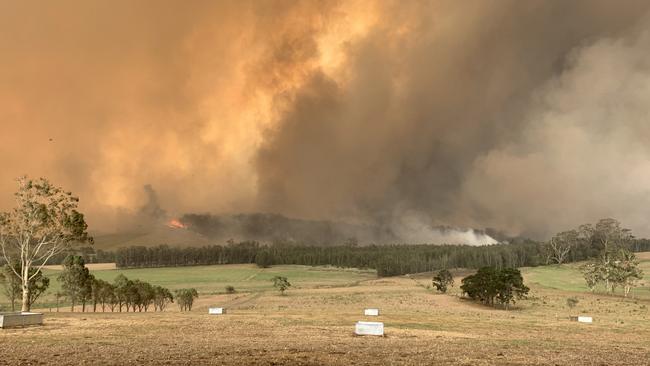Report reveals how Australia’s future could look if global warming keeps rising
The world is set to hit 1.5C of warming within the next 20 years, so what does that future look like for those in Australia?

Climate Change
Don't miss out on the headlines from Climate Change. Followed categories will be added to My News.
Australia is inching towards an unliveable future that could see “1-in-10-year” extreme heat events happen in nine out of 10 years instead.
A new report from the United Nations has confirmed the world has warmed by 1.1 degrees celsius, with Australia actually warming by a much higher 1.4C.
“It is unequivocal that human influence has warmed the atmosphere, ocean and land,” the Intergovernmental Panel for Climate Change (IPCC) report states.
The significant rise in temperatures is already having impacts, with the report noting that Australasia, which includes New Zealand, has already experienced more hot extremes, higher rates of sea level rise than the global average, decrease in snow cover and depth, an increase in the frequency of fire weather days, a longer fire season and less rainfall during winter in southern Australia.
Globally, marine heatwaves, which are linked to the bleaching of the Great Barrier Reef, have doubled in frequency since the 1980s.
“Unfortunately, we can expect worsening impacts on coral reefs from marine heatwaves in the future,” Monash Climate Change Communication Research Hub climate consultant Neil Plummer said.
These impacts are expected to get worse as temperatures continue to rise.
The IPCC report states that every extra 0.5C of global warming, causes “clearly discernible increases” in the intensity and frequency of heatwaves, high rainfall and droughts in some regions.
RELATED: ‘Death sentence’: Australia has warmed 1.4C

Extreme daily rainfall events are expected to intensify by about 7 per cent for each 1C of warming. The proportion of category 4-5 tropical cyclones are also expected to increase.
The more that warming increases beyond 1.5C, the more unpredictable the impacts become and scientists say they cannot rule out extreme scenarios such as ice sheet collapse or abrupt ocean circulation changes, despite them being very unlikely.
The IPCC expects global temperatures will exceed 1.5C of warming within 20 years, based on current climate pledges.
Up to 2.5C of warming within 40 years is expected, with the world is on track for 3.5C of warming by the end of the century.
The way climate change impacts the environment can vary across regions but can also include more intense rainfall and associated flooding, as well as more intense drought.
In high latitudes, rainfall is likely to increase while it is projected to decrease in large parts of the subtropics.
Extreme sea level events that previously occurred once in 100 years could happen every year by the end of this century.
Cities may also be impacted differently, as urban areas are usually warmer, and could also face more flooding due to heavier rainfall and sea level rise.
The Arctic is likely to be practically sea ice free in September at least once before 2050 even under the most aggressive emissions reduction scenario modelled.
However, there are some big differences between 1C of warming, which is what the world is experiencing now, compared to 1.5C, 2C and 4C.
RELATED: Report details catastrophic outcome of 3C warming

Where we are now: 1 degree of warming
We’ve already seen an increase in extreme weather as a result of climate change.
For example, what was once considered a “1-in-10 year” extreme heat event, now occurs nearly three times every decade.
Such heatwaves are on average 1.2C warmer than pre-industrial levels.
Where we could be within 20 years: 1.5C of warming
At 1.5C of warming, what was once considered a “1-in-10 year” extreme heat event will occur more than four times per decade.
Such heat events will be on average 1.9C warmer than pre-industrial levels.

Where we could be if we don’t act: 2C of warming
Without immediate, rapid and large-scale reductions in greenhouse gases, we’re likely to breach 2C of warming by mid-century.
In this scenario, those “1-in-10 year” heat events will instead occur every second year, and will be more than 2.5C warmer than they once were.
Not only that, but in places like south and east Australia, what were previously considered 1-in-10 droughts will be 2.5 times more likely to occur.
Heavy rainfall events will almost double.
If emissions go higher: 4C
At 4C of warming, what was once considered a “1-in-10 year” extreme heat event, will occur in 9 out of 10 years.
Such heatwaves will be on average 5C warmer than pre-industrial levels.
‘We can still stay below 1.5C’
The world appears to have locked in 1.5C of warming but the most ambitious plans for emissions reductions could see it remain around this level.
If emissions decline to net zero around or after 2050, warming will reach 1.5C in the 2030s, then rise to 1.6C before dropping down to 1.4C at the end of the century.
“We can still stay below 1.5C, but it will not be achieved with belated and incremental measures,” European Climate Foundation chief executive officer Laurence Tubiana said.
“The Paris Agreement laid out a clear framework for governments to accelerate action: sadly many big polluters are ignoring a treaty they helped deliver, and are breaking promises they made in 2015.
“World leaders need to get serious about climate change.”
IPCC Working Group I Co-Chair Valérie Masson-Delmotte said: “this report is a reality check”.
“We now have a much clearer picture of the past, present and future climate, which is essential for understanding where we are headed, what can be done, and how we can prepare.”
charis.chang@news.com.au | @charischang2
Originally published as Report reveals how Australia’s future could look if global warming keeps rising



